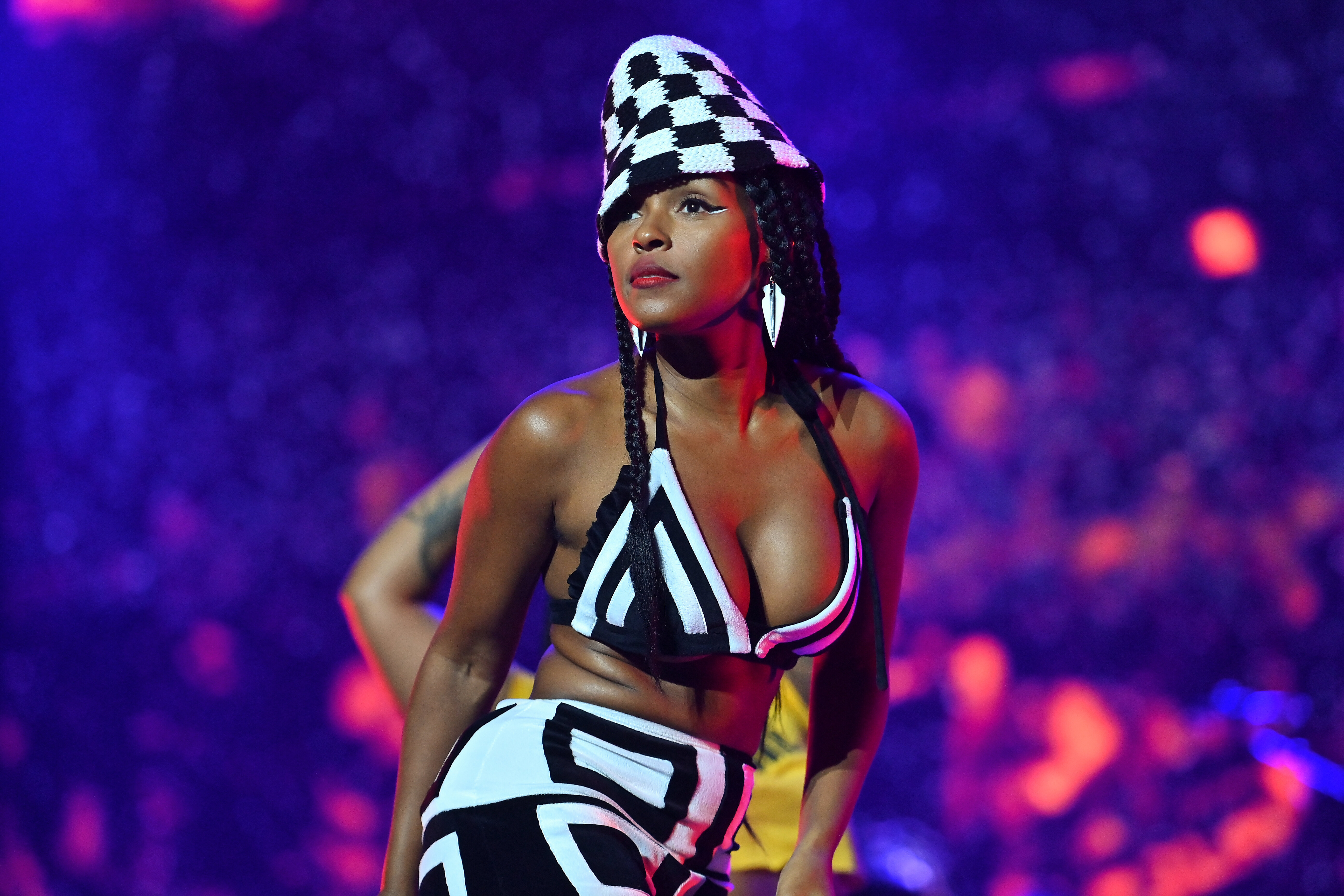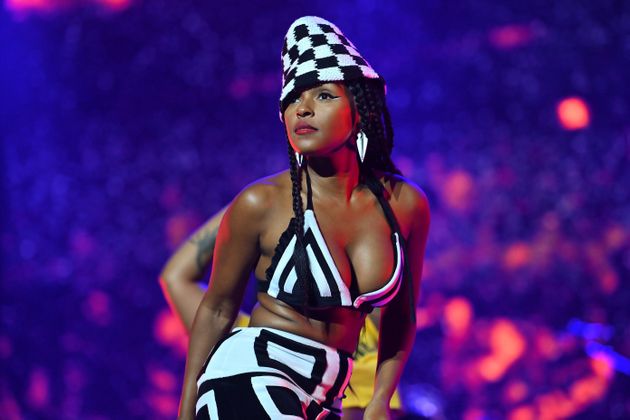
The music video for Lipstick Lover, one of the singles off Janelle Monáe’s newest album, The Age of Pleasure, feels vibrantly decadent. In it, the singer rises out of a pool, their areolas peering through a sheer white T-shirt that reads “Pleasure.” Booties are shaking, dildos are falling and Monáe is the curator of the queer desire that oozes on screen.
Just last week, at Essence Fest in New Orleans, Monáe brought a bit of that energy on stage by flashing a petal-covered nipple during two of their songs. ”[I’m] much happier when my t**ties are out,” they recently told Rolling Stone. Well, I’m happy for them.
Advertisement
To the more conservative viewer, this behaviour is borderline pornographic. But for everyone who gets it, it’s an organic next step in the evolution of Monáe’s burgeoning self-expression as an out, queer artist.
Long before Monáe came out as pansexual in 2018 and nonbinary in 2022, baby gays like myself were drawn to the subliminal messaging of queerness in their tuxedo looks, as well as the intentionally androgynous branding of their gender.
In 2017, I was a junior in high school, just beginning to explore music genres beyond the classical and Christian pop that underscored my childhood and early teens. When I discovered Monáe’s work, it felt like a universe of language had been unlocked. They quickly became my role model as I struggled to reconcile my queerness with my religious upbringing.
“Say will your God accept me in my black and white? / Will he approve the way I’m made? / Or should I reprogram, deprogram and get down?” Monáe sings on Q.U.E.E.N., a song on their 2013 album, The Electric Lady.
Advertisement
Somehow, Monáe seemed to understand how my queerness conflicted with my Christian self — I was programmed to become a god-fearing daughter who would settle down with a nice Chinese boy and rear children of my own. Like Monáe, I found my artistic expression first through singing and leading worship within the context of an insular ethnic and religious community.
Monáe grew up the child of Black American middle-class workers in Kansas City, and I was the eldest daughter of immigrants who worked as public school teachers in the Chinese American suburbs of Los Angeles. But our paths intersected, it became evident, as they expressed the tension of their identities. For years, Monáe also shielded their queerness in the armour of ambiguity. Part of that, they say, has been in direct opposition to the overt fetishisation of Black women’s bodies in the music industry.
As their career developed, Monáe bucked what was even subconsciously expected of them. They were a dark-skinned Black femme wearing androgynous clothing, for years they eluded the countless questions about their sexuality and gender. “I only date androids,” was their response to it all. You couldn’t put Monáe’s music, their body or gender squarely into any one box, which gave them a level of agency not often afforded to queer Black artists.
Like Monáe, I’ve found myself at times caught between two identities as an artist. My queerness and Asianness are inextricable from each other as I navigate the world as a nonbinary non-white person. When I perform poems for an Asian American space, I feel the need to emphasise my queerness in my poetry. In queer spaces, that are more often than not white, there’s an urgency to talk about my Asian American upbringing. Monáe has shown me that exploring these intersections can be both challenging and invigorating.
The evolution of Monáe’s gender and sexual expression ebbed on Dirty Computer, an album that saw them diving into the explorations of desire and attraction with both men and women. Monáe repatriates elements of Prince’s iconic guitar riff in Kiss for their song Make Me Feel as they fall between the arms of two people, feminine- and masculine-presenting lovers. Another song, Pynk, a fuchsia-infused music video, featured Monáe frolicking in the desert with fellow queer actor Tessa Thompson while wearing labia-shaped pants and panties that read “I grab back” — a direct clap back to Donald Trump’s infamous “locker room talk.”
Advertisement
At this point, Monáe had also secured their status as a respected actor on the Oscar-nominated Hidden Figures (2016) and Oscar winner Moonlight (2016). Around that time, they also founded Wondaland Records, which allowed them directorial and creative control of their image and artistry as a musician. All of this allowed them to reclaim the portrayal of their body — as well as the political messaging of their mere existence in the industry.
In 2022, when Monáe first introduced their gender-neutral pronouns publicly, their fame somewhat protected them from conservative backlash or the confusion of a largely cisgender straight American society. But, of course, some people loiter in the distance awaiting their downfall. And, evident in they’re commitment to the spectrum of queer expression and resistance to body policing, they cannot be concerned.
“No I’m not the same… I think I done changed… I used to walk into the room head down. / I don’t walk, now I float,” Monáe proclaims on their newest album’s opening track, “Float.”
Monae does float, with transcendent confidence, on The Age of Pleasure. The influences of reggae and dance hall, and the sounds of the Caribbean are heard on this 10-song summer album, a move that inherently queers traditions of music that have at times been rooted in homophobia, sexism and misogyny.
There’s something vulnerable and dangerous in placing themselves directly into the narrative of Black queer joy. If capitalism and racism amount to the sexual objectification of Black and melanated bodies, let me do it on my own terms, Monáe’s newest work screams.
Advertisement
“Whether I show skin or I don’t, I’m sexy. I just always felt like people would try their best to take my autonomy away from me,” Monáe shared recently in an interview with StyleLikeU. “It took me years to feel comfortable with my boobs,” they added in the interview. Seeing Monáe fully embracing their queerness in all its joy (and sexiness) in 2023 feels like the strongest rebuke against the fearmongering and shame that’s threatening to roll back LGBTQ+ rights across the US.
Monáe has taught me that sexuality is political and that being nonbinary can be a beautiful journey. There will continue to be hundreds of interpretations of Monáe’s work from ArchAndroid to a sexually liberated and self-described “free-ass motherfucker.” That’s part of being an artist: You release work that is absorbed into the culture and takes on a new meaning. For me, their work is about how every year can reveal new ways to love yourself.
Like Monae says on another new track Phenomenal: “I’m looking at a thousand versions of myself. And we’re all fine as fuck.”



